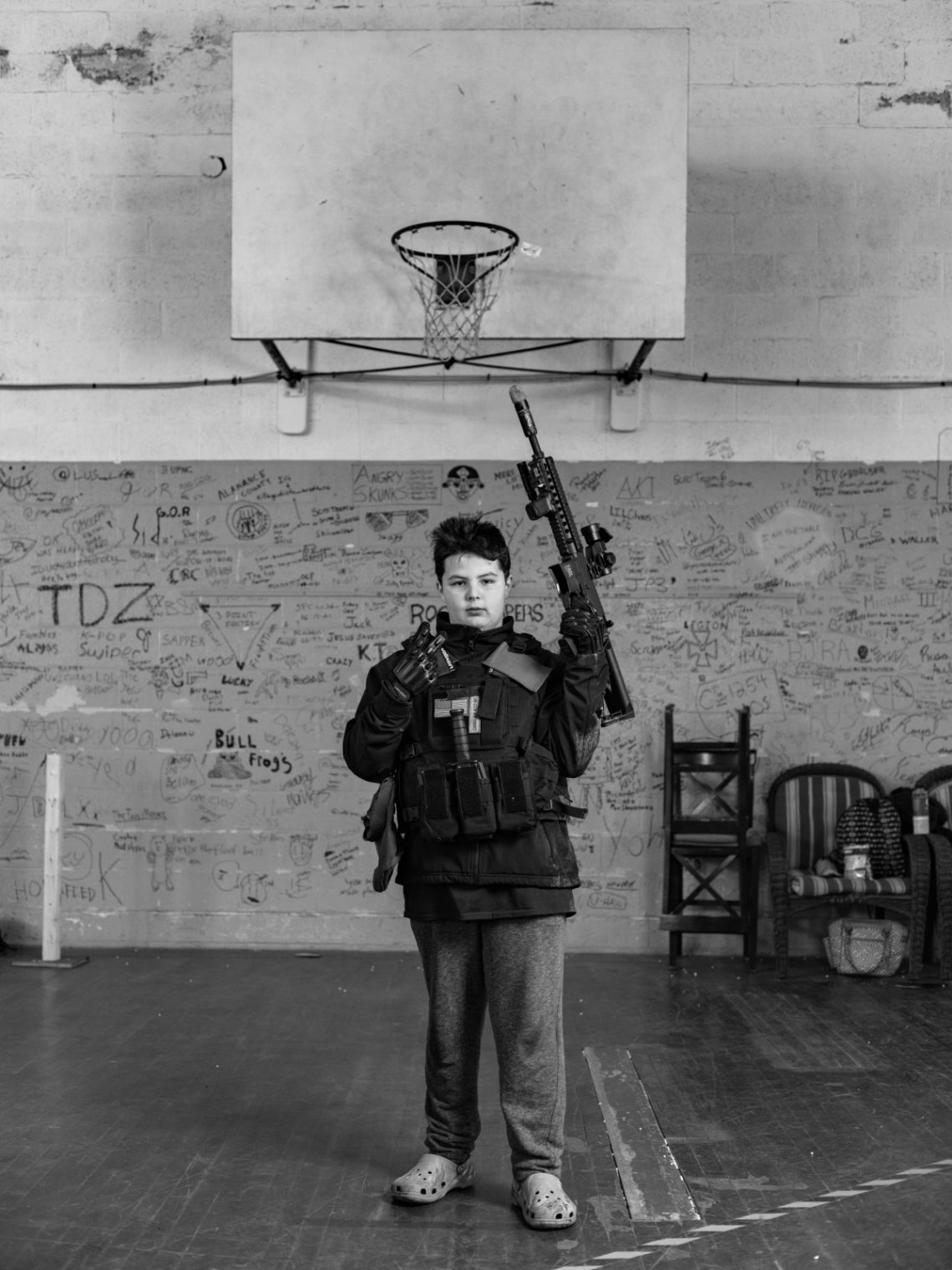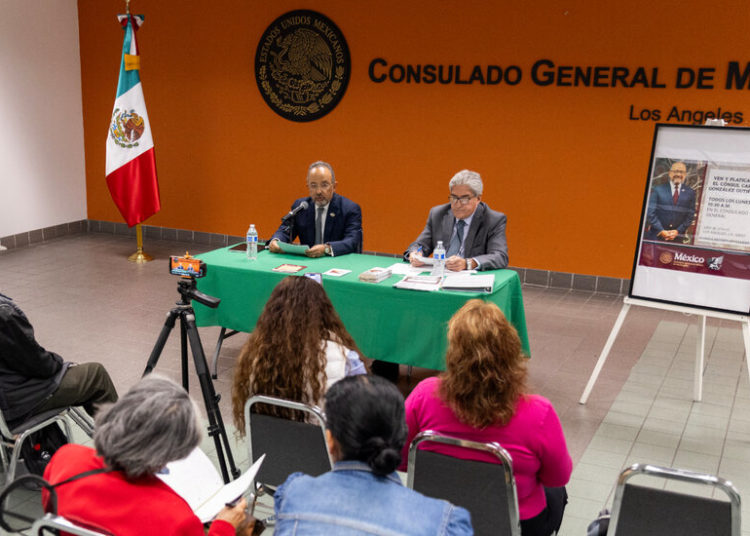In an old derelict school in rural North Carolina, Americans of all ages, races, and genders unite to praise God and shoot each other.
Yes, the bullets may just be plastic, but the shooters’ commitment to creating a realistic warfare situation is extreme: any uninformed onlooker would assume they were witnessing a militia in training.
This is Rockingham Airsoft and Tactical Support, aka RATS, a God-fearing Airsoft facility rooted where faith and fun blend together in a weird and violent way.
After serving as a combat photographer with the U.S. Marines in Afghanistan and the Philippines, Matthew Troyer returned home, pursued a formal art education, and began to focus on the ways in which American military culture permeates everyday civilian life, from what people wear to their sense of self and how they should spend their leisure time.
In his eye-opening project, Playing at War, he visited RATS to document the tight-knit community taking shape there and reflect on what it says about the increasingly divided atmosphere of the country.
We caught up with Troyer to chat about God, guns, and the increasingly blurry line between fantasy and reality.
VICE: Hi Matthew. What inspired Playing at War?
Matthew Troyer: It was the idea of militarized leisure and aestheticized violence. Before looking into Airsoft, I’d wanted to look into militia groups. And that led me to think about war cosplay. I was just scrolling through Facebook and for some reason, the algorithm gave me Airsoft. It was someone in England playing and they were in a full ghillie suit, pretending to be a sniper. I thought it was really crazy looking. I went on Google and started looking for similar stuff where I live, and I found RATS.
What was interesting about RATS in particular?
First of all, it’s in an abandoned elementary school, to which I was like: What the fuck? The school was abandoned and deteriorating, and a family in the community decided to buy it and start RATS. They thought it would be a cool way to get people together.
So, highly realistic simulated gunfights in an abandoned elementary school, in a country that experiences the highest number of school shootings on the planet. That reminds me of one of your photos that really struck me: a young man in military gear with a gun strapped to him, standing next to a sign that says “drug-free school zone.”
Yeah, there are a lot of layers to that image. That juxtaposition of recognizing drugs as a threat, but not seeing the normalization of violence as one.
What was the mood like at the Airsoft club?
I went in blind. I just showed up one day with a camera. When you don’t understand the game and how it works, then it looks a lot like a militia. Once I started speaking to people, I realized they were mostly wonderful, loving, and caring people just trying to have fun, and they welcomed all races and genders. To them, this kind of game was just normal, and there was nothing weird about it.
In your mind, what’s the difference between playing this highly realistic IRL simulation of warfare, and playing something like Call of Duty?
In some ways, it’s similar, in others vastly different. In video games, you’re not actually holding a rifle, pointing it at another human being, and pressing a trigger. Whether or not it’s a bullet or just a BB pellet that comes out, I think there’s a desensitization to violence that occurs.
How committed are people to simulating the experience as realistically as possible?
Some people are way more devoted than others. The son of the family who started it, he has his own squad called ‘The Reapers.’ They’re actually very close to being like what a military unit is: They’re very serious about their gameplay and they have a sort of brotherhood camaraderie. It’s stuff I think a lot of men are lacking and looking for.
Then you get others who are more goofy about it: One guy was running around with swords and screaming at people. But it was the people who took it very seriously that fascinated me. They really want to look like they’re a real Navy SEAL. Even the firearms themselves are incredibly realistic. They’re made of metal and have a working bolt system, so it actually looks like how a real gun fires. People will spend $600 or more on a super-realistic rifle and outfit.
As someone who served in the military, how does it make you feel when you see kids as young as ten years old engaging in this?
I have so many mixed feelings. For a start, I think the world would be better off if we understood multiple things could be true at once. Part of me sees these kids having fun, engaging with their community, and not sitting at home on their phones. Another part of me thinks: Oh my god, they look like child soldiers, and it reminds me of horrendous things I saw in Afghanistan. It’s also just weird to see civilians who want to be in the military so bad yet aren’t in the military, and are engaged in this role-play instead.
However, seeing children handling firearms will always feel problematic to me. Growing up, I was never allowed to touch guns. I had an uncle who hunted and he didn’t even allow his kids to have nerf guns. So, to see this crazy ritualized combat activity happening in an elementary school with children… It’s unsettling.
Are you worried that the border between role-play and reality is more porous than we think?
I think it’s a slow creep. In the military and law enforcement, we have something called dry fire drills, where you’re going through the motions of an activity to create muscle memory. At these Airsoft games, young children are actually going through the motions of handling a weapon and firing it at someone. I’m no psychologist, but I feel like when you do that, there is a degradation in your brain somewhere, and whatever wall there was starts to erode.
Your work made me think a lot about how powerful a force the military-entertainment complex is in the U.S., and while the people playing this Airsoft game are just trying to have fun, the whole activity is wrapped up in a much larger ideological phenomenon in which militarism is permeating more and more aspects of everyday life. I found myself thinking about some of the pictures that came out of the January 6 Capitol attack in 2021, of people who probably hadn’t served in the military, but were dressed in the gear and acting like militia. It had LARPing feel to it, and it was telling that when they got inside, a lot of them had no idea what to do next, they just took selfies and stole stuff.
There are parallels for sure. There’s something strange regarding hypermasculine aesthetics involved in all this. The stereotypical ideas of a strong American male are the cowboy and the soldier, and a lot of men still gravitate towards those. I think men are yearning for some idea of masculinity that they think they’re missing out on, for some reason. In truth, I think they are desperately searching for purpose and community. Then there’s the militarism [the ideology that glorifies military values] that seeps into the culture, fueling identity and becoming something people want to emulate, while militarization [the process by which culture becomes infused with military characteristics] shapes the aesthetics and behaviors of everyday life. That’s how you end up with people thinking that to be a patriotic American means holding two M16s and firing into the air. All these weird cultural things are happening at once.
The integration of religion into these Airsoft spaces is a haunting aspect of your work. In one audio clip, you recorded the activity leader asking the participants if they would like to say the Lord’s Prayer before it begins or “… do you just want to shoot some people?” What interested you about this intersection of religion and war games?
I have a term for this, I call it “spiritualized militarism.” There’s a Judeo-Christian background that undergirds everything in America. There’s this idea that if I’m winning it’s because God let me—it’s big in the military too. As soon as I walked into RATS, one of the first things I noticed was the banner over the door reading: “Jesus is Lord.” I spoke to the organizers and they said they don’t force religion on anyone, but they want people to know they are religious; it was part of their community building. I found it fascinating that a facility like this had been turned almost into a place of worship. This building, once a school for children, is now a place for ritualized, simulated combat.
What message do you want viewers to take away from your work?
The thing I’ve learned is that I need to have a critical voice, especially today in the divided states of America. We need to keep our eyes open to what’s going on in the country. We should be engaging with people who have different ideas and ways of living their lives to us, while also maintaining a critical stance. And I’m saying this as a gun-owning military veteran. Activities like the one I’ve documented clearly provide fun and enrich the community, but what are the potential negative side effects? As an artist, I want to spark these kinds of conversations.
Thanks, Matthew.
The post ‘It’s Unsettling’: The School Where American Kids Rehearse Militia Warfare appeared first on VICE.




